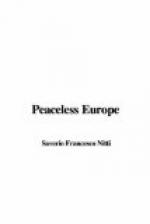The documents published by Kautsky in Germany and those revealed from time to time by the Moscow Government prove that the preparation for and conviction of war was not only on the part of the Central Empires, but also, and in no less degree, on the part of the other States. One point will always remain inexplicable: why Russia should have taken the superlatively serious step of general mobilization, which could not be and was not a simple measure of precaution. It is beyond doubt that the Russian mobilization preceded even that of Austria. After a close examination of events, after the bitter feeling of war had passed, in his speech of December 23, 1920, Lloyd George said justly that the War broke out without any Government having really desired it; all, in one way or another, slithered into it, stumbling and tripping.
There were three Monarchies in Europe, the Russian, German, and Austro-Hungarian Empires, and the fact that they were divided into two groups necessarily led to war. It was inevitable sooner or later. Russia was the greatest danger, the greatest threat to Europe; what happened had to happen under one form or another. The crazy giant was under the charge of one man without intelligence and a band of men, the men of the old regime, largely without scruples.
Each country of Europe has its share of responsibility, Italy not excluded. It is difficult to explain why Italy went to Tripoli in the way in which she did in 1911, bringing about the Italo-Turkish war, which brought about the two Balkan wars and the policy of adventure of Serbia, which was the incident though not the cause of the European War.
The Libyan adventure, considered now in the serene light of reason, cannot be looked on as anything but an aberration. Libya is an immense box of sand which never had any value, nor has it now. Tripolitania, Cyrenaica and Fezzan cover more than one million one hundred thousand square kilometres and have less than nine hundred thousand inhabitants, of whom even now, after ten years, less than a third are under the effective control of Italy. With the war and expenses of occupation, Libya has cost Italy about seven milliard lire, and for a long time yet it will be on the debit side in the life of the nation. With the same number of milliards, most of which were spent before the European War, Italy could have put in order and utilized her immense patrimony of water-power and to-day would be free from anxiety about the coal problem by which it is actually enslaved. The true policy of the nation was to gain economic independence, not a barren waste. Ignorant people spoke of Libya in Italy as a promised land; in one official speech the King was even made to say that Libya could absorb part of Italian emigration. That was just a phenomenon of madness, for Libya has no value at all from the agricultural, commercial or military point of view. It may pay its way one day, but only if all expenses are cut down and the administrative system is completely changed. It may be that, if only from a feeling of duty towards the inhabitants, Italy cannot abandon Libya now that she has taken it, but the question will always be asked why she did take it, why she took it by violence when a series of concessions could have been obtained without difficulty from the Turkish Government.




